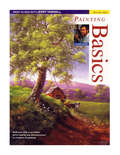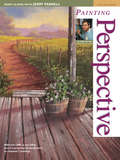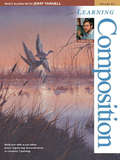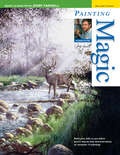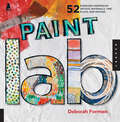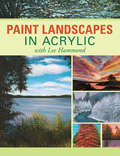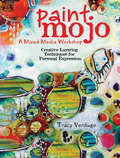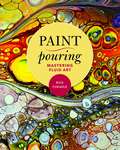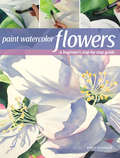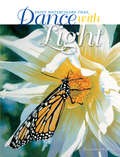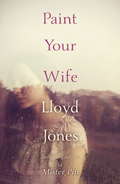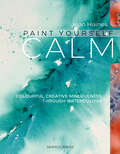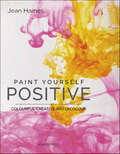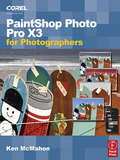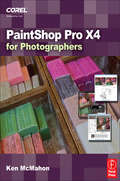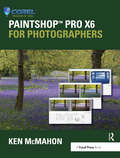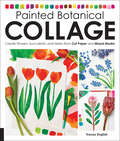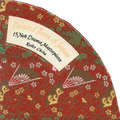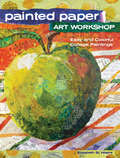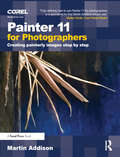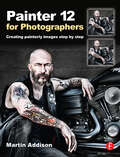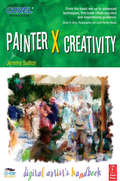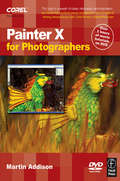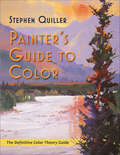- Table View
- List View
Paint Along with Jerry Yarnell Volume One - Painting Basics (Paint Along with Jerry Yarnell)
by Jerry YarnellYou can transform a blank canvas into a spectacular landscape even if you've never painted before. Jerry Yarnell-the master of popular painting-will show you how with his successful step-by-step painting techniques. You'll learn to create beautiful art, building your skills and having fun every time you approach the canvas. The lessons inside will enable you to produce 10 complete paintings and provide you with detailed information on subjects such as color mixing, applications, composition, value studies, depth perception and much more. Whether you're a beginning, intermediate or advanced painter, Jerry Yarnell's 28 years of art experience will inspire and enrich your painting journey-a lifelong learning process full of discovery and wonder.
Paint Along with Jerry Yarnell Volume Seven - Painting Perspective (Paint Along with Jerry Yarnell)
by Jerry YarnellLove to paint? Want to learn? Then let's get started!With Jerry Yarnell at your side, it's easy to make your artistic dreams come true. In this fun and easy guide, he provides tips and tricks for mastering one- and two-point perspective - the keys to adding realistic buildings and other man-made objects to your paintings.You'll also find complete step-by-step instruction for painting seven idyllic landscapes, plus proven techniques for painting everything from windmills and rural houses to adobe buildings and old weathered wood.Whether you're ready to start your very first painting or add new subjects to your work, this book is the only key you need to unlock your creative potential. Put yourself on the road to artistic success today!
Paint Along with Jerry Yarnell Volume Six - Learning Composition (Paint Along with Jerry Yarnell)
by Jerry YarnellLove to paint? Want to learn? Then let's get started!In Learning Composition, Jerry Yarnell helps you reach new levels of artistic expertise. Inside, he provides insightful, easy-to-follow instructions for building effective compositions - the kind of dynamic designs that will make your paintings pop!Drawing upon more than thirty years of painting and teaching experience, Jerry details three different types of composition, the principles of good design, the proper use of negative space and more. Seven gorgeous, step-by-step painting projects illustrate each concept in action.From lovely log cabins and mountain peaks to rocky roads and windmills, Jerry makes it easy to increase your skills and confidence. Grab your brush and paints and get started today!
Paint Along with Jerry Yarnell Volume Three - Painting Magic (Paint Along with Jerry Yarnell)
by Jerry YarnellLove to paint? Want to learn? Then grab your paints and brushes and get started!Learn all the tricks and techniques you need to perform "magic" with paint! In Painting Magic, the third volume of his popular painting series, Jerry Yarnell helps you move beyond the basics and begin tackling more involved paintings.You'll find ten beautiful step-by-step projects, each designed to provide a new set of artistic challenges that help you to master composition, design, perspective, value, color and atmosphere.Paint gorgeous mountain cliffs, weathered adobe buildings, mist-shrouded forests, a rustic farm, a covered bridge and more! Jerry makes it easy for you to improve, expand your repertoire or skills and build true artistic confidence.
Paint Lab: 52 Exercises Inspired by Artists, Materials, Time, Place, and Method (Lab)
by Deborah FormanPaint Lab is packed with unique and experimental techniques and ideas in painting. This hands-on book is organized into 52 units, which may, but don't need to be explored on a weekly basis. The labs can be worked on in any order, so that you can flip around to learn a new mixed-media technique or be inspired by a particular painting theme or application. The underlying message of this book is that, as an artist, you should learn and gain expertise through experimentation and play. There is no right or wrong result, rather you will find new forms of expression in your work and gain confidence in your skills. Designed to inform and inspire new artists and rekindle passion for painting in experienced artists, this book offers a range of exercises broken down by theme: Who (artist-inspired), What (tools and materials), When (a time-based concept), Where (a sense of place), and How (inspired by a technique or method). Paint Lab is illustrated with brilliant full-color images and multiple examples of each exercise. This book offers you a visual, non-linear approach to learning painting techniques, and reinforces a fun and fearless approach to creating art.
Paint Landscapes in Acrylic with Lee Hammond
by Lee HammondEnjoy the scenery with fast and fun landscape painting!A summer sunset, a bubbling brook, a sea of golden wildflowers like nature itself, landscape painting doesn't have to be complicated to be beautiful. In this beginner-friendly guide, Lee Hammond shows you how to use a handful of colors, a simple three-step approach, and the friendly medium of acrylic to create charming landscapes throughout the seasons.Step-by-step instructions for painting favorite landscape elements—skies, trees, grasses, mountains, water and more—provide endless mix-and-match possibilities.16 paint-along landscape projects can be completed quickly, using no more than 8 colors each.Basic brushwork techniques, easy-to-learn painting methods, and lots of step-by-step instruction get beginners painting fast.One of the most popular art instruction authors out there with 20+ years of experience, Lee Hammond shares tried-and-true secrets for achieving a sense of distance, evoking mood, painting realistic textures, and much more... everything you need to turn any moment in nature into a personal work of art.
Paint Mojo - A Mixed-Media Workshop: Creative Layering Techniques for Personal Expression
by Tracy VerdugoClaim the beauty of your unique, authentic expression. Break free of your comfort zone, sharpen your senses to perceive the world around you and find happiness in play. On this painterly journey, Tracy Verdugo leads you from self-doubt to self-appreciation by helping you find your voice through a myriad of vibrantly-hued mark making, painting and self-reflection techniques. There are no mistakes here, only opportunities to learn and grow. Learn the language of your own sacred marks by painting with personal symbology. Discover the inspiration that exists around you, in your home, your community, the present moment. 19 step-by-step exercises use popular mixed media materials such as pastels, acrylic paints, inks and more! See how to use art making to plant creative seeds and cultivate your wildest dreams. Turn on your Paint Mojo and make an awesome, shiny, perfectly imperfect mark of you.
Paint Pouring: Mastering Fluid Art
by Rick CheadlePaint Pouring is a form of abstract art that uses acrylic paints with a runny (fluid) consistency. The acrylic paints react with each other when combined to make interesting and visually organic motifs. Fluid acrylics can be used on many types of substrates through various techniques such as pouring, dripping, swirling, glazing, dipping, and more to create dazzling and masterful effects. This book provides everything you will need to become a paint pouring artist. Learn to: Set up your paint pouring studio on a budget Complete your supply list Discover a variety of techniques Properly handle and care for your art Establish appropriate mixing ratios Achieve correct paint density And many other lessons crucial to the craft This new art form is fun for all ages. Become a fluid art master today.
Paint Watercolor Flowers: A Beginner's Step-by-Step Guide
by Birgit O'ConnorYou can paint beautiful blooms, step by step! Sunflowers, orchids, daffodils, lilies...your brush can bring these and more to life with Paint Watercolor Flowers. Master watercolorist Birgit O'Connor guides you every step of the way, from selecting essential watercolor supplies, to practicing basic painting techniques, to capturing the unique details of a variety of flowers, to showing them off in striking, color-rich compositions. Learn how to paint nine different flowers, with each demonstration covering important concepts you need for successful results. Friendly, easy-to-follow instructions make flower painting fun and doable for any artist, whether you are new to the medium or simply want to try a subject you haven't painted before.Detailed instruction on color, value, creating shadows, composition and more3 negative painting demonstrations9 start-to-finish flower painting demonstrations exploring topics such as creating backgrounds, layering color, values in white flowers, values in colored flowers and much moreLearn to play with gorgeous color and water effects, expressing yourself with the unparalleled beauty of nature's bouquet.
Paint Watercolors That Dance with Light
by Elizabeth KincaidElizabeth Kincaid invites readers to follow her proven techniques for painting dazzling scenes drenched in color. Her beautiful flowers, foliage and landscapes will have readers eager to create their own--and they will, using: Easy-to-follow step-by-step instructions that take the mystery out of composition, color, light and shadow A practical guide to masking and glazing Newly trained eyes to visualize before painting and to better perceive abstract form, value, line and color All levels of watercolorists, as well as color enthusiasts of all mediums, will enjoy using Kincaid's tips to create vivid paintings infused with light!
Paint Your Wife
by Lloyd JonesThe next morning Alma showed up with his tin case of pencils and his sketchbooks. She showed him through to the sitting room. She had an idea that a sitting was a formal occasion and in preparation had gone around the room straightening cushions and pulling off furnishing covers. She had dressed herself up in her Sunday best, a black skirt and red blouse. She had been toying with putting a flower in her hair.Long ago, when the men were away at the war, Alma began painting the women of the town. Alice, his favourite, returned his attentions, and when her husband George came home from the war, he set out to prove his love and reclaim his wife by moving a hill to improve the view for her - with a spade and wheelbarrow.Now, decades later, the townspeople, looking to escape various corners of despair, turn to Alma's drawing classes and, in doing so, learn to rediscover each other. For when you draw, the only thing that matters is what lies before you. Paint Your Wife is a colourful, sensual novel, brimming with rich stories and even richer characters.
Paint Yourself Calm: Colourful, Creative Mindfulness Through Watercolour
by Jean HainesDiscover the happiness benefits of putting brush to paper with a guide that puts judgment aside and “encourages simple enjoyment of painting” (Library Journal).Meditative, peaceful, and calming, watercolour painting offers a sense of control and self-worth to everyone, with no judgment or goal beyond the joy of painting itself. This book shows you how to calm and enhance your outlook through the movement of brush on paper.Master artist Jean Haines leads you through the journey, putting the emphasis on the joy of play rather than on pressure to perform or produce—and showing you how to wipe away your worries with the soothing, gentle strokes of watercolour paint.“Starting from the premise that everyone can paint, Haines frees readers of the goals and expectations of end results, and encourages simple enjoyment of painting. Open-ended, detailed exercises guide readers through experimenting with paint to gain a sense of control; to relieve stress; to escape; or to be in a better mood. The emotional and psychological properties of color are discussed as are obstacles to creativity and happiness. . . . [a] unique blend of self-care and expression.” —Library Journal
Paint Yourself Positive: Colorful Creative Watercolour
by Jean HainesBestselling international author and artist Jean Haines’ new book takes readers on an exciting journey through painting. Not just a book for artists, this is for anyone looking for a way of enhancing their life and mood through paint. It’s also a way into art for people who have never painted and may even have been told they 'can’t paint’ at an early age. If you love the idea of sitting down and playing with colour and paint as a distraction from the stresses of modern life, then this is the book for you!All of Jean’s books have promoted the life-enhancing effects of painting, and this is especially relevant in Paint Yourself Positive. Whether you can already paint or not, the aim of the book is for you to create in a way that you find pleasing, increases your self-confidence and leaves you feeling energized. Jean will very soon have you wanting to pick up a paintbrush and start to paint – and loving every second of it.
PaintShop Photo Pro X3 for Photographers
by Ken McMahonIf you are a digital photographer who's new to Paint Shop Pro Photo or digital imaging in general, or have recently upgraded to the all-new version XX, this is the book for you! Packed with full color images to provide inspiration and easy to follow, step-by-step projects, you'll learn the ins and outs of this fantastic program in no time so you can start correcting and editing your images to create stunning works of art. Whether you want to learn or refresh yourself on the basics, such as effective cropping or simple color correction, or move on to more sophisticated techniques like creating special effects, everything you need is right here in this Corel-recommended guide. Useful information on printing and organizing your photos and a fantastic supplemental website with tons of extras rounds out this complete PSPP learning package.
PaintShop Pro X4 for Photographers
by Ken McMahonGreat for those new to PaintShop Pro or digital imaging in general, this book is packed with inspirational, full-color images and easy to follow, step-by-step projects that will have you producing great images in PaintShop Pro in no time! Everything you need to turn your photos into stunning works of art is right here in this Corel-reviewed guide. In this new edition, Ken covers new features including how to make the most of the newly organized workspaces, use the redesigned HDR tool, and instantly publish photos on Flickr and Facebook. Squeeze every ounce of detail out of RAW files using the newly enhanced Camera RAW Lab and improve tonal range with the new Fill light/Clarity filter. This book has everything a photographer needs to take their photos to the next level with PaintShop Pro. Be sure to visit the companion website www.gopaintshoppro.co.uk for practice files, bonus tutorials and other fabulous resources.
PaintShop Pro X6 for Photographers
by Ken McMahonWritten for photographers of all levels, PaintShop Pro X6 for Photographers is packed with inspirational, full-color images and easy-to-follow step-by-step projects that will have you producing great images in PaintShop Pro in no time! Everything you need to enhance and improve your digital photography is right here in this Corel® endorsed guide. In this new edition, Ken McMahon looks at the pros and cons of the new, faster 64-bit version of the software and covers new features, including working with the Instant Effects palette, using the Smart selection brush, mapping photos, automatically tagging people, and uploading to Facebook, Flickr, and Google+. Other program features—selections, masking, layers, adjustments and effects, HDR, and scripting—are explained through practical examples that are just as relevant for older versions of the software. This book has everything a photographer needs to take their photos to the next level with PaintShop Pro. Learn from PaintShop Pro expert Ken McMahon with the most authoritative book on PaintShop Pro endorsed by Corel®. Completely revised and updated with all of the new features in X6—get up to speed with 64-bit processing power, new selection tools, workspace enhancements, and much more. A complete learning package with full-color screen shots and examples, and step-by-step projects at the end of each chapter.
Painted Botanical Collage: Create Flowers, Succulents, and Herbs from Cut Paper and Mixed Media
by Tracey EnglishWith Painted Botanical Collage, artists of all skill levels will learn to create lifelike botanical artwork—featuring flowers, succulents, and herbs—using painted background papers and elegant collage techniques. A unique technique book, Painted Botanical Collage will show you how to create your own collage materials. This guide takes you step by step through creating mixed-media painted papers, then using them—along with tissue paper, art papers, and found paper, such as magazines—to create perfect collage materials. Cut these decorative papers into plant and flower parts to assemble your designs, adding details using various media.Working from nature is central to this technique—look closely at the palettes and shapes in actual flowers to create realistic stylized representations. Painted Botanical Collage includes instruction on creating flowers, cacti, succulents, leaves, and other popular botanicals—over 30 beautiful designs in all. Join in the fun as British artist Tracey English shares the methods behind the magical flower collages that charm and delight her Instagram followers.
Painted Fans of Japan
by Reiko ChibaThe chief purpose of this modest little book is to present for Westerners some of the gorgeous paintings found on fans used in tne traditional Japanese Non drama. Painting as limited to conform to the fan shape has teen practiced for hundreds of years in Japan, even hy such immortal artists as Sotatsu and Korin. Until now, however, there has heen no popularly availahle volume of reproductions to reveal the almost limitless possibilities in color, design, and perspective within this restricted form of painting, The artists whose works are reproduced in this book are unknown, and the time when the works were painted can only he estimated as early (1601-1741), middle ( 1742-1791 ) , or late ( 1792-1867 ) Totugawa, the period of Japanese history that extended from the beginning of the seventeenth century to well past the middle of the nineteenth.
Painted Paper Art Workshop: Easy and Colorful Collage Paintings
by Elizabeth St. HilaireThis is where painting meets collage! You can create beautiful art with amazing depth and texture, using easy collage techniques and paper you paint yourself. Popular workshop instructor Elizabeth St. Hilaire makes it fun and simple no matter what your skill level! Start with materials you probably already have--fluid acrylics, stencils, a few household items and paper--and hand-paint your personalized paper palette using basic techniques anyone can do. Then move through each step of composing your own work of art. You'll find beautiful, meaningful examples of the how and why on every page. You'll learn how to: develop your composition, how to work with simple shapes, important lessons on value and much more.More than 30 techniques for painting your own decorative papersStep-by-step instructions for creating your own painted paper collage-from underpainting and directional ripping and tearing to auditioning your papers and combining collage with mixed mediaA spectacular gallery of paper paintings to inspire and dazzle--still lifes, figures, animals and landscapes
Painter 11 for Photographers: Creating painterly images step by step
by Martin AddisonWhether you are new to Painter or a seasoned pro wanting to take your digital art to the next level, this inspirational book and DVD package will show you how to get the most out of Corel's powerful painting software.Starting with the basics and moving on to cover brushes, textures, cloning, toning and other effects, Martin Addison will help you master the tools and features needed to transform your photographs into stunning works of art. Over 2 hours of video tutorials and clear, step-by-step examples take you through the techniques in a no-nonsense manner, with all images provided on the accompanying DVD so you can learn by doing. Packed with beautiful images to illustrate what can be achieved with the right skills and know-how, Painter XI For Photographers will inspire you to get creative with your personal or commercial photographs.
Painter 12 for Photographers: Creating painterly images step by step
by Martin AddisonTransform your photographs into stunning works of art with this fully updated, authoritative guide to the all-new Painter 12. Whether you are new to Painter or a seasoned pro wanting to go further with your digital art, Painter 12 for Photographers will show you how to get the most of Corel's powerful painting software. Starting with the basics and moving on to cover brushes, textures, cloning, toning, and other effects, Martin Addison will help you master the techniques needed to transform photographs into beautiful painterly images. Packed with vivid images to illustrate what can be achieved with the right skills and know-how, Painter 12 for Photographers will inspire you to get creative with your photographs.
Painter X Creativity: Digital Artist's handbook
by Jeremy SuttonEmpower your artistry in the digital environmentThis unique Painter book addresses both creative and technical proficiency, helping you step ahead in today's world of photography, art, multimedia, and design. This lavishly illustrated guide speaks directly to all visual artists and shows you how to combine traditional and stateof-the-art media to capture the essence of your vision.Fully updated for Corel Painter X and the newest range of Wacom graphics tablets, progressive, well-structured tutorials from beginner to advanced level, case studies, and examples of art will inspire your imagination at every stage. Let world-renowned Painter master Jeremy Sutton guide you step-by-step in how to experiment with creative ideas and techniques that you can adapt to your own style.New time-saving tips, workflow strategies, and keyboard short cuts allow you to quickly transform your work with Corel Painter X's outstanding natural-media tools. From expressive paintings to evocative collage portraits, oil impressionism, live portrait paintings, and painterly effects for video, television, and the Web, you get the best techniques through...*Clear explanations with colorful screen grabs and inspiring artworks that lead youthrough the sophisticated and creative Painter tools*Practical, hands-on tutorials, and project illustrations that show you every step inimage development, including multimedia artist techniques*A CD-ROM packed with unique custom brushes, tutorial images, and additional artmaterials not supplied with Painter XIncluded on the resource CD:*48 extra brushes including many unique custom brushes not supplied with Painter *38 custom color sets*Jeremy's SupaDoopa custom palettes to help speed up your workflow*Collection of Jeremy's favorite Image Hose nozzles, paper textures, and patterns to greatly enhance the variety and richness of art materials available at your fingertips*Gain instant access to Jeremy's interface customization and optimize your creativity with unique custom workspaces, new to Painter X*4 QuickTime movies including a studio tour, artwork commentary, and details on Wacom tablets*Have fun practicing with 28 tutorial images!
Painter X for Photographers: Creating Painterly Images Step by Step
by Martin AddisonWhether you are just starting out with Painter, or are a seasoned pro who wants to take your photographs to the next level, you can't go wrong with this essential guide by your side! Covering Painter X, but also applicable to earlier versions and to both PC and Macintosh users, this reader friendly book and DVD package will show you how to get the most out of this powerful program. Uniquely written specifically for photographers, Martin Addison gives a complete overview of the program, showing how to master each exciting tool, including the brand-new RealBristle and Smart Stroke brush libraries. Two all-new portraiture chapters show you how to turn photographs of your family members or professional clients into works of art ideal for framing. You'll be able to give all of your precious photographs the painterly touch in no time! Be sure to visit the accompanying website www.painterforphotographers.co.uk to view even more images and information to get you started! Pictures by Martin and Doreen Addison can be seen on their website: www.martinanddoreen.co.uk.
Painter's Guide to Color: The Definitive Color Theory Guide
by Stephen QuillerThe Premier Guide for Painters to Understanding Color! Painter's Guide to Color was written foremost with the painter in mind. However, weavers, textile designers, interior decorators, and commercial artists have all benefited from award-winning artist Stephen Quiller's innovative and accessible color theory techniques. Painter's Guide to Color will help you to train your eye to see and use color in exciting ways.
Painter's Life: Talks, Journals, Paintings
by Mari LyonsA Painter&’s Life is a rare glimpse into the mind of an uncompromising painter. Mari Lyons was a life-long &“every-day&” painter and from an early journal she kept for a short time she reveals the heartbreaks, the pain of rejection, the intense and abiding love of her work, and the quiet triumphs of a painter juggling the demanding life of a mother of four, a busy husband, constant financial pressure; she had a fierce desire to make ever-better work, and for her work to become more visible in the world. Later talks she gave at the Munson William Proctor Institute and Rider University frame the journal entries with the aesthetic concepts that animate her work. This look at her inner life is made more palpable by a selection of more than eighty-five representative paintings in color, along with sketches and photographs. Mari studied with Max Beckmann as a teenager, and later at Bard College, Yale-Norfolk, and with Stanley William Hayter. Her early work received high praise in college and from her first exhibition at the Polari Gallery in Woodstock when she was nineteen and still a student. She married at twenty-one, had three children in as many years, and then moved from the Midwest to New York City, where her fourth child was born.At first influenced by the Abstract Expressionists of the 1950s, she painted non-objectively but soon found the rich thingness of the world irresistible and her work developed into what she called &“painterly figuration.&” Her journals and notes reveal the intimate details of her long mediation between these two commitments. In time she exhibited regularly at the First Street Gallery in Chelsea and received praise in such places as The Wall Street Journal, The New Republic, The New York Times, The Sun, Forbes FYI, and elsewhere. Today her paintings are in The Museum of the City of New York, The New York State Museum, Bard College, The Montana Historical Society, Mills, Wellesley, and Russell Sage colleges, The Montana Museum of Art, and many other museums and private collections.
